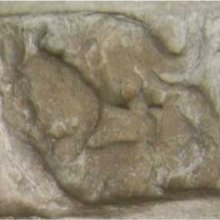At, Aṭ, Āṭ, Āt: 12 definitions
Introduction:
At means something in Hinduism, Sanskrit, biology. If you want to know the exact meaning, history, etymology or English translation of this term then check out the descriptions on this page. Add your comment or reference to a book if you want to contribute to this summary article.
Images (photo gallery)
(+1303 more images available)
In Hinduism
Vyakarana (Sanskrit grammar)
Source: Wikisource: A dictionary of Sanskrit grammarAṭ (अट्).—(I) token term standing for vowels and semi-vowels excepting l (ल् (l)) specially mentioned as not interfering with the substitution of ṇ (ण् (ṇ)) for n (न् (n)) e.g. गिरिणा, आर्येण, खर्वेण (giriṇā, āryeṇa, kharveṇa) etc. Sec P.VIII.4.2; (2) augment a (अट् (aṭ)) with an acute accent, which is prefixed to verbal forms in the imperfect and the aorist tenses and the conditional mood. e.g. अभवत्, अभूत्, अभविष्यत् (abhavat, abhūt, abhaviṣyat) Sec P.IV.4.71; (3) augment a (अट् (aṭ)) prescribed in the case of the roots रुद्, स्वप् (rud, svap) etc. before a Sārvadhātuka affix beginning with any consonant except y (य् (y)), e.g. अरोदत्, अस्वपत्, अजक्षत्, आदत् (arodat, asvapat, ajakṣat, ādat) etc.; see P.VII.3, 99, 100;(4) augment a (अट् (aṭ)) prefixed sometimes in Vedic Literature to affixes of the Vedic subjunctive (लेट् (leṭ)) e.g. तारिवत्, मन्दिवत् (tārivat, mandivat) etc. see P.III.4.94.
--- OR ---
1) Āṭ (आट्).—Augment आ (ā) prefixed to roots beginning with a vowel in the imperfect, aorist and conditional, which is always accented (उदात्त (udātta)); cf. P.VI.4.72;
2) Āṭ.—Augment आ (ā) prefixed to the imperative first person terminations, e.g. करवाणि, करवै (karavāṇi, karavai) etc.; cf. P.III.4.92:
3) Āṭ.—Augment आ (ā) to be prefixed to caseaffixes which are डित् (ḍit) after nouns called nadī: e.g. कुमार्यं (kumāryaṃ); cf P.VII. 3.112.
--- OR ---
1) Āt (आत्).—Long आ (ā) as different from short or protracted अ (a) prescribed by the wofd वृद्धि (vṛddhi) or दीर्घ (dīrgha) in the case of अ (a), or by the word आत् (āt) when substituted for another vowel, as for example in the rule आदेच उपदेशेऽशिति (ādeca upadeśe'śiti) and the following: cf. P.VI.1.45, 57;
2) Āt.—Substitute for the ablative affix ङस् (ṅas) after words ending in अ; cf. P. VII.1.12;
3) Āt.—Substitute आत् (āt) for a case affix in Vedic Literature, e.g. न ताद् ब्राह्मणाद् निन्दामि (na tād brāhmaṇād nindāmi) Kāś. on VII. 1.39.

Vyakarana (व्याकरण, vyākaraṇa) refers to Sanskrit grammar and represents one of the six additional sciences (vedanga) to be studied along with the Vedas. Vyakarana concerns itself with the rules of Sanskrit grammar and linguistic analysis in order to establish the correct context of words and sentences.
Biology (plants and animals)
Source: Google Books: CRC World Dictionary (Regional names)At in India is the name of a plant defined with Annona squamosa in various botanical sources. This page contains potential references in Ayurveda, modern medicine, and other folk traditions or local practices It has the synonym Guanabanus squamosus M. Gómez (among others).
Example references for further research on medicinal uses or toxicity (see latin names for full list):
· Field Museum of Natural History, Botanical Series (1938)
· Fl. Haban. (1897)
· Species Plantarum (1753)
· Cytologia (1990)
· Taxon (1981)
· Etnoflora Yucatanense (2004)
If you are looking for specific details regarding At, for example pregnancy safety, extract dosage, chemical composition, diet and recipes, health benefits, side effects, have a look at these references.

This sections includes definitions from the five kingdoms of living things: Animals, Plants, Fungi, Protists and Monera. It will include both the official binomial nomenclature (scientific names usually in Latin) as well as regional spellings and variants.
Languages of India and abroad
Sanskrit dictionary
Source: DDSA: The practical Sanskrit-English dictionaryAṭ (अट्).—1 P. (rarely A.) (aṭati, āṭa, aṭitum, aṭita). To wander or roam about (with loc.); roam over (sometimes with acc.); भो बटो भिक्षामट (bho baṭo bhikṣāmaṭa) Sk. go beg alms; आट नैकटिकाश्रमान् (āṭa naikaṭikāśramān) Bhaṭṭikāvya 4.12; महीमटन् (mahīmaṭan) Daśakumāracarita 38 -desid. अटिटिषति (aṭiṭiṣati); -freq अटाठ्यते (aṭāṭhyate) to wander about habitually, as a religious mendicant.
--- OR ---
At (अत्).—1 P. (ati), अतति, अतितुम्, अत्त-अतित (atati, atitum, atta-atita)
1) To go, walk; wander, to go constantly.
2) To obtain (mostly Ved.)
3) To bind.
4) (antati) To bind.
--- OR ---
Āt (आत्).—The letter आ (ā). ind. Ved.
1) Afterwards, then; generally used antithetically to यद्, यदा, यदि (yad, yadā, yadi) and then sometimes strengthened by the particles अह, उ, इद् (aha, u, id) &c.
2) Then, further, also, and (api ca).
3) Some-times it only strengthens the meaning of another word or gives emphasis to an interrogative pronoun like उ, अङ्ग, नु (u, aṅga, nu) added to किम् (kim) (possibly, at all).
Source: Cologne Digital Sanskrit Dictionaries: Shabda-Sagara Sanskrit-English DictionaryAṭ (अट्).—[aṭa] r. 1st cl. (aṭati) To move, to go or approach: with pāra prefixed, to go round about, to roam, to rove, to ramble, to wander about, especially as a religious mendicant. 10th cl. (aṭayati) To slight.
--- OR ---
At (अत्).—[ata] r. 1st cl. (atati) To go, to move or approach progressively and continually. With an indicatory i. ati (aṃtati) To bind.
Source: Cologne Digital Sanskrit Dictionaries: Benfey Sanskrit-English DictionaryAṭ (अट्).—i. 1, [Parasmaipada.] (in epic poetry also [Ātmanepada.], Mahābhārata 3, 1586), To roam, with the loc. and acc. Mahābhārata 1, 1031; [Daśakumāracarita] in
— With the preposition pari pari, To wander about, [Pañcatantra] 55, 1. Puryaṭita, n. Wandering about, [Pañcatantra] 70, 12.
--- OR ---
At (अत्).—i. 1, [Parasmaipada.] 1. To go. 2. To move continually.
--- OR ---
Āt (आत्).— (the regular abl. sing. n. of the pronoun idam) adv. Then,
Aṭ (अट्).—aṭati aṭate ±pari) walk about, roam.
--- OR ---
At (अत्).—atati atate walk about, wander, run.
--- OR ---
Āt (आत्).—([ablative] [adverb]) from this, afterwards, thereupon, then, further, often [correlative] to yad, yadā, yadi and followed by it.
Source: Cologne Digital Sanskrit Dictionaries: Monier-Williams Sanskrit-English Dictionary1) Aṭ (अट्):—[class] 1. [Ātmanepada] [Parasmaipada] aṭati, te, āṭa, aṭiṣyati, āṭīt, aṭitum, to roam, wander about (sometimes with [accusative]; frequently used of religious mendicants) :
—[Intensive] aṭāṭyate, to roam or wander about zealously or habitually, especially as a religious mendicant:—[Desiderative] aṭiṭiṣati, to be desirous of roaming.
2) At (अत्):—1. at ind. a prefix said to imply ‘surprise’, probably a contraction of ati, meaning ‘extraordinary’, ([gana] ūry-ādi, q.v.)
3) 2. at [class] 1. [Ātmanepada] [Parasmaipada] atati ([Naighaṇṭuka, commented on by Yāska]; p. atat or atamāna),
—to go constantly, walk, run, [Ṛg-veda];
—to obtain, [cf. Lexicographers, esp. such as amarasiṃha, halāyudha, hemacandra, etc.]
4) Āṭ (आट्):—ind. a croak (imitation of the sound uttered by a frog), [Tāṇḍya-brāhmaṇa]
5) Āt (आत्):—ind. ([ablative] of 4. a) afterwards, then (often used in a concluding paragraph antithetically to yad, yadā, yadi. and sometimes strengthened by the particles aha, id, īm, u), [Ṛg-veda; Atharva-veda]
6) then, further, also, and, [Ṛg-veda; Atharva-veda] It is sometimes used after an interrogative pronoun (like u, nu, aṅga) to give emphasis to the pronoun, [Ṛg-veda]
Source: Cologne Digital Sanskrit Dictionaries: Goldstücker Sanskrit-English DictionaryAṭ (अट्):—I. (aṭa-bhvādi-udātta-udāttet) r. 1st cl. par. (aṭatiāṭa-aṭitā-aṭiṣyati-āṭīt.—Caus. āṭayati-āṭiṭat.—Desid. aṭiṭiṣati.—Intens. aṭāṭyate.) To go round about, to roam, to rove, to ramble, to wander about, especially as a religious mendicant. With pari—the same with an intense meaning. Ii. (aṭa-curādi-parasmaipadin) r. 10th cl. par. (āṭayati) To slight &c. See aṭṭ Ii, of which it is given as a various reading.
--- OR ---
At (अत्):—[ata-bhvādi-udātta-udāttet] r. 1st cl. par. (atatiāta-atitā-atiṣyati-ātīt.—p. p. atita and ātta.)
1) To go, to move.
2) To move continually.
3) To obtain. With abhi-
1) To approach.
2) To obtain.—ava- To go down.— sam- To approach, to hasten to.
--- OR ---
At (अत्):—ind. A particle which is said to imply surprise or astonishment. It occurs only in adbhuta according to the native etymology, and perhaps also in addhā. It belongs to those indeclinables which in conjunction with radicals are called gati q. v.
Source: Cologne Digital Sanskrit Dictionaries: Yates Sanskrit-English Dictionary1) Aṭ (अट्):—aṭati 1. a. To move; with pari to wander about.
2) (ka) aṭayati 10 a. To slight.
3) At (अत्):—atati 1. a. To move constantly.
4) (i) antati 1. a. To bind.
[Sanskrit to German]
Sanskrit, also spelled संस्कृतम् (saṃskṛtam), is an ancient language of India commonly seen as the grandmother of the Indo-European language family (even English!). Closely allied with Prakrit and Pali, Sanskrit is more exhaustive in both grammar and terms and has the most extensive collection of literature in the world, greatly surpassing its sister-languages Greek and Latin.
Kannada-English dictionary
Source: Alar: Kannada-English corpusAt (ಅತ್):—[noun] the short vowel 'a' (as in Saṃskřta).
Kannada is a Dravidian language (as opposed to the Indo-European language family) mainly spoken in the southwestern region of India.
See also (Relevant definitions)
Starts with (+5614): A-tintukurri, Aatmanishth, Aatmaniyantran, Aatmasanyamee, Aatmatyag, Aatmavrittant, Aatmgaurav, Aatmsaat, Aatmsaat-garnu, Aggigaliga, Anmabhimarshana, Anmavasya, Anmayasa, Anmeccha, Anmollasa, Arthya, At tora, At-ker, Ata, Ata igbo.
Ends with (+5310): Aagat, Aaghat, Aahat, Aakhyat, Aapat, Aapatvipat, Aatmsaat, Aavat-jaavat, Aayat, Ababaat, Abaddhavat, Abalavat, Abdimat, Abhagyavat, Abhaktimat, Abhavat, Abhavayat, Abhibhanjat, Abhibhashat, Abhibhavat.
Full-text (+33124): Atya, Atavi, Samipa, Ata, Paryatana, Karaskaratika, Ekada, Shanda, Aat hateri, Aat-alarie, Sandhya, Sthuloccaya, Vistara, Aghara, Mrigaya, Ati, Arat, Atkatiyan, Karhi, Kamarupa.
Relevant text
One of your search terms exceeds the minimun character amount per search term. This amount currently equals 2.
No search results for At, Aṭ, Āṭ, Āt, Aat; (plurals include: Aats) in any book or story.
Related products
(+168 more products available)











